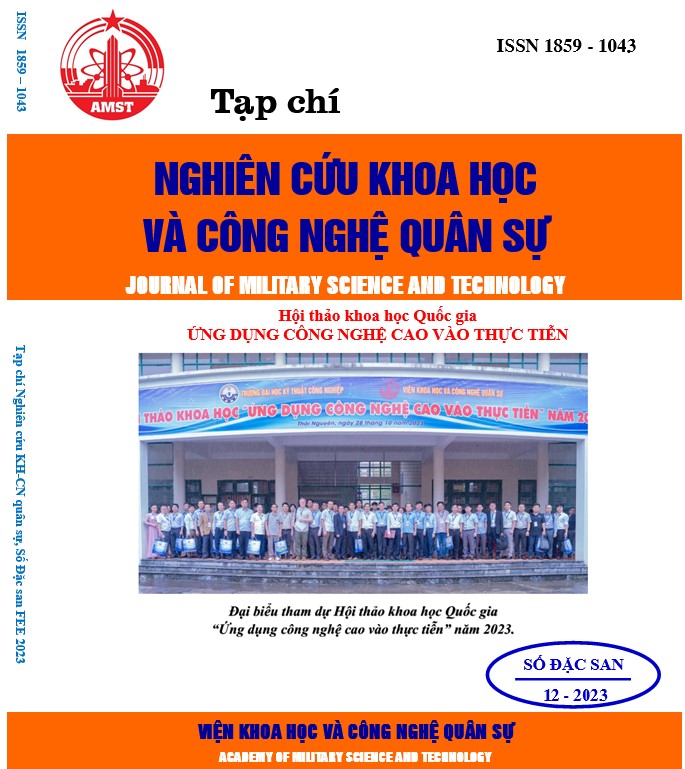A model for permeability of porous media under fully saturated conditions
461 viewsDOI:
https://doi.org/10.54939/1859-1043.j.mst.FEE.2023.141-148Keywords:
Permeability; Porous media; Porosity; Capillary; Fractal.Abstract
Permeability is an important parameter that describes the ability of a porous medium to transmit water under saturated or nearly saturated conditions. It governs the flow of fluids and migration of contaminants beneath the ground surface, especially in soils and aquifers. The permeability depends on properties of porous media such as porosity, cementation, pore size, pore size distribution, pore shape and pore connectivity. In this work, we develop a model for permeability in porous media under saturated conditions using a capillary bundle model. The proposed model relates the permeability to properties of porous media such as maximum pore radius, minimum pore radius, porosity, tortuosity and fractal dimension for pore space. The model is then successfully compared to existing experimental data and a widely used model from the literature.
References
[1]. Soldi M, Guarracino L and Jougnot D, “A simple hysteretic constitutive model for unsaturated flow”, Transport in Porous Media, 120, 271-285, (2017). DOI: https://doi.org/10.1007/s11242-017-0920-2
[2]. Jackson M. D, “Characterization of multiphase electrokinetic coupling using a bundle of capillary tubes model”, J. Geophys. Res.: Solid Earth, 113, 005490, (2008). DOI: https://doi.org/10.1029/2007JB005490
[3]. Yu B, Cheng P, “A fractal permeability model for bi-dispersed porous media”. Int J Heat Mass Transf, 45, 2983–2993, (2002). DOI: https://doi.org/10.1016/S0017-9310(02)00014-5
[4]. Duy Thanh, Luong, et al. "A physically based model for the electrical conductivity of water-saturated porous media" Geophysical Journal International, 219, 866-876, (2019). DOI: https://doi.org/10.1093/gji/ggz328
[5]. Ghanbarian, Behzad. "Applications of critical path analysis to uniform grain packings with narrow conductance distributions: II. Water relative permeability" Advances in Water Resources, 137, 103524, (2020). DOI: https://doi.org/10.1016/j.advwatres.2020.103524
[6]. Landis, E. M., “Poiseuille's law and the capillary circulation”, American Journal of Physiology-Legacy Content, 103, 432-443, (1933). DOI: https://doi.org/10.1152/ajplegacy.1933.103.2.432
[7]. Buckingham E., “Studies on the movement of soil moisture”, US Department of Agriculture, Bureau of Soils no. 38, USDA, Washington, DC, 61 pp, (1907).
[8]. Sing, K.S., “Characterization of porous materials: past, present and future”, Colloids and Surfaces A: Physicochemical and Engineering Aspects, 241, 3-7, (2004). DOI: https://doi.org/10.1016/j.colsurfa.2004.04.003
[9]. Widiatmoko, E., Abdullah, M. and Khairurrijal, “A method to measure pore size distribution of porous materials using scanning electron microscopy images”, Aip conference proceedings, 1284, 23-26, (2010). DOI: https://doi.org/10.1063/1.3515554
[10]. Liang M, Yang S, Miao T and Yu B, “Analysis of electroosmotic characters in fractal porous media”, Chemical Engineering Science, 127 (2015). DOI: https://doi.org/10.1016/j.ces.2015.01.030
[11]. Du Plessis J. P and Masliyah J. H, “Flow through isotropic granular porous media”, Transp. Porous Media, 6, 207–221, (1991). DOI: https://doi.org/10.1007/BF00208950
[12]. Kozeny J, “Uber kapillare leitung des wassers im boden aufsteigversikeung und anwendung auf die bemasserung” Math-Naturwissen-schaften, 136, 271-306, (1927).
[13]. Revil A and Cathles L. M., “Permeability of shaly sands”, Water Resources Research, 3, 651-662, (1999). DOI: https://doi.org/10.1029/98WR02700
[14]. Bole`ve A, Crespy A, Revil A, Janod F and Mattiuzzo J. L, “Streaming potentials of granular media: Inuence of the dukhin and reynolds numbers”, J. Geophys. Res.: Solid Earth, 112, 1-14, (2007). DOI: https://doi.org/10.1029/2006JB004673
[15]. Glover P, Zadjali I. I and Frew K. A, “Permeability prediction from micp and nmr data using an electrokinetic approach”, Geophysics, 71, 49-60, (2006). DOI: https://doi.org/10.1190/1.2216930
[16]. Glover P. W. J and Walker E, “Grain-size to effective pore-size transformation derived from electrokinetic theory”, Geophysics, 74, 17-29, (2009). DOI: https://doi.org/10.1190/1.3033217
[17]. Glover P. W. J and Dery N, “Streaming potential coupling coefficient of quartz glass bead packs: Dependence on grain diameter, pore size, and pore throat radius”, Geophysics, 75, 225-241, (2010). DOI: https://doi.org/10.1190/1.3509465
[18]. Kimura M, “Prediction of tortuosity, permeability, and pore radius of water-saturated unconsolidated glass beads and sands”, The Journal of the Acoustical Society of America, 141, 3154-3168, (2018). DOI: https://doi.org/10.1121/1.5039520
[19]. Thanh L. D, Jougnot D, Solazzi S. G, Nghia, N. V, Van Do P, “Dynamic streaming potential coupling coefficient in porous media with different pore size distributions”, Geophys. J. Int., 229, 720–735, (2022). DOI: https://doi.org/10.1093/gji/ggab491







